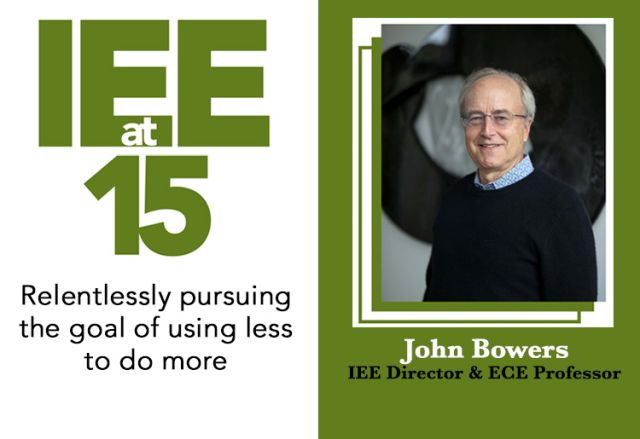
Excerpt from the COE/CLS Convergence magazine (Summer 2024) - "IEE at 15"
The Institute for Energy Efficiency at 15
Since it was established in 2008, the Institute for Energy Efficiency (IEE) at UC Santa Barbara has become a juggernaut of collaborative interdisciplinary innovation. The nearly one hundred current affiliated faculty and their predecessors, in disciplines ranging from economics and electrical engineering to physics, biochemistry, materials, and environmental policy, have made dozens of groundbreaking discoveries and developed important technologies and strategies related to three interdisciplinary pillars, or themes: Smart Societal Infrastructure (SSI), Energy Efficient Computing and Communications (EECC), and the Food-Energy-Water Nexus (FEWN). Here, we offer just a glimpse of some of the much larger universe of research being undertaken by IEE affiliates.
The IEE was created as existentially significant questions about environmental sustainability were coming into sharper focus and becoming a larger part of the global conversation. The challenge presented by those questions has only deepened in the years between the institute’s founding and its fifteenth anniversary, celebrated last November, two years after it moved into LEED Platinum–certified Henley Hall.
“We have a problem, and it is becoming increasingly clear to all of us that, as a society, as a university, as a college of engineering, as an institute, we need to fix it,” says UCSB professor and IEE director, John Bowers, whose research on laser-based photonics has been key to many major gains in energy-efficient data transmission, including the fact that, as he says, “Computing is perhaps a thousand times more efficient than it was fifteen years ago.”
The problem Bowers is referring to, which is also closely related to the subject of this issue’s cover story on battery research (see page 18), is climate change and the increasingly urgent need it presents to wean ourselves from reliance on the fossil fuels that drive it and also cause a host of other related environmental and health problems. During its first fifteen years, the IEE has more than lived up to the promise of making meaningful contributions to an energy-efficient, clean-energy future. While most projects fit within one of the three main research pillars, many others closely relate to, complement, or overlap with another pillar, or even two other pillars.
The pillars are a useful organizational tool, but, as you will see by reading on, they never prevent a project from being taken on because it doesn’t altogether “fit” into one or another broad theme. That is what makes it possible for Nobel laureate and professor of materials and electrical and computer engineering Shuji Nakamura to collaborate with his fellow materials professor and co-director of the UCSB Solid State Lighting and Energy Electronics Center (SSLEEC), Steven DenBaars, and chemical engineering professor and catalysis expert Phillip Christopher to design new LED lasers expressly to enhance faster, more energy efficient catalytic processes. At many universities, such a project might never happen at all, much less receive a $50,000 IEE seed grant to begin the work. Such overlapping interests, coupled with an eager willingness to embrace broad — and broadly interdisciplinary — themes reflects UCSB at its most effective and goes a long way toward explaining IEE’s tremendous impact and outstanding worldwide reputation.
“Thanks to the generosity of [lead Henley Hall donors] Jeff and Judy Henley and others, IEE has grown to become a campus lightning rod in the best sense, getting people together to address the efficiency side of sustainability,” says COE dean, Umesh Mishra, who is also a leading researcher and entrepreneur in gallium nitride-power electronics. “If you waste less energy, you have to generate and store less energy from renewables, so efficiency is what takes the pressure off the system. At UCSB, we are naturally collaborative, and what Henley Hall and IEE did was to create a home for people to sit alongside each other and have the kind of cross-disciplinary collaborations required to address energy efficiency at large. The building creates a kind of tornado effect, if you will, whipping all the collective energy into a nice strong Force 5 effort.”
While Bowers and his fellow IEE researchers in photonics-based electronics have achieved enormous gains, Bowers, the Fred Kavli Chair in Nanotechnology, remains keenly aware of a conundrum. He explains: “Every efficiency gain is made in the context of the ever-increasing need for power and computing. So, if you are a thousand times more efficient, but you are doing five-thousand times more computing, that’s a net loss, not a gain. We need to treat that.”
“In the short term, say, the next ten to twenty years, energy efficiency will still be the biggest thing you can do to reduce a carbon footprint,” says Jeff Henley, who is also vice chairman of Oracle and a member of the COE Dean’s Cabinet. “At IEE, we’re doing a lot of basic research and working closely with companies like Google, Microsoft, Facebook, and others, which allows us to educate people who can work for those companies, as well as people who will stay in the research role in universities. So, IEE is assuming a very prominent role in what UCSB science and engineering do. And we have to keep getting better, because you never want to stand still.”
Learn more about the current research at The IEE
- "AI and Energy" – William Wang, CS Prof. (page 13)
- "Cloud over Agriculture" – Chandra Krintz & Rich Wolski, CS Profs. (page 14)
- "Beyond LEDs" – Steven Denbaars & Shuji Nakamura, ECE and Materials Profs. and Phillip Christopher, ChemE Prof. (page 15)
- "Making Infrastructure “Smart'" – Mahnoosh Alizadeh, ECE Assoc. Prof. and Igor Mezić, ME Prof. (page 16)
- "Chasing Quantum" – Galan Moody, ECE Assoc. Prof.; John Martinis, Physics Prof.; and Ania Jayich, Physics Prof. & Stephen Wilson, Materials Prof. (page 17)
The COE/CLS Convergence magazine (Summer 2024) - "IEE at 15" (full article pg. 12)